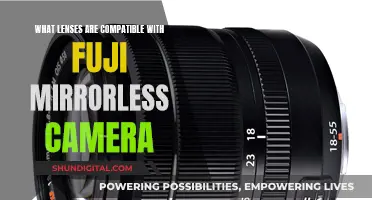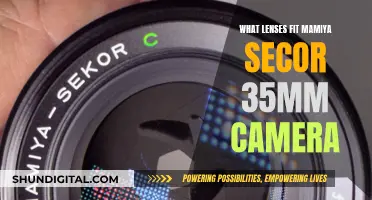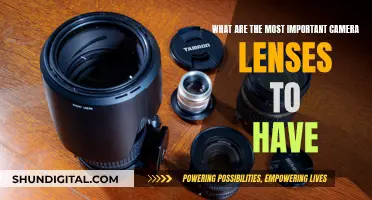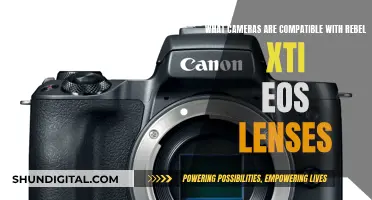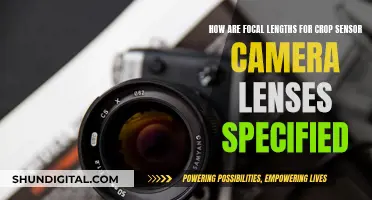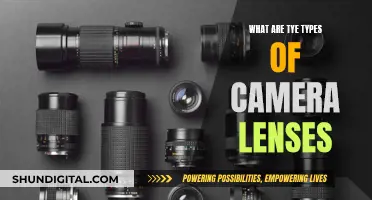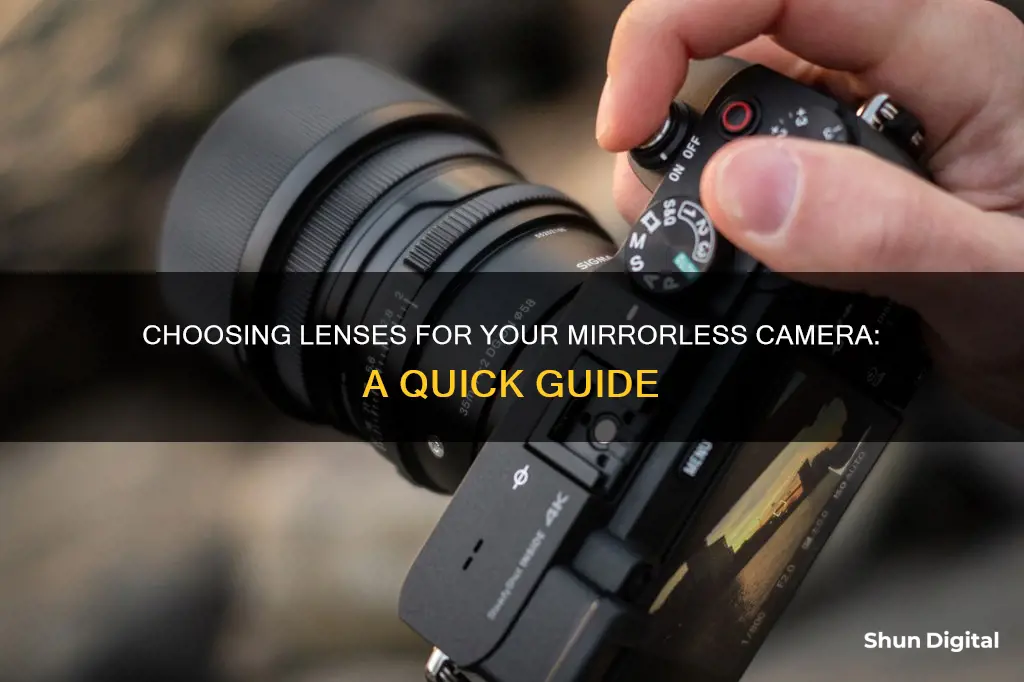
Choosing the right lens for your mirrorless camera is crucial to unlocking its full potential. The lens you choose will depend on the type of photography you want to do, your budget, and the specific features you require. Here are some factors to consider when selecting a lens for your mirrorless camera:
- Compatibility: Ensure that the lens is physically compatible with your camera. Check if your camera has a cropped sensor size (APS-C) or a full-frame sensor, as this will determine the lenses that will fit and work properly.
- Focal Length: The focal length dictates the angle of view and how wide or zoomed-in your image will be. A shorter focal length provides a wider image, while a longer focal length allows for more zoom. Different types of lenses, such as wide-angle, standard, telephoto, and macro, offer varying focal lengths suitable for different types of photography.
- Aperture: The aperture, or f-stop number, controls the depth of field and the amount of light entering the lens. A lower f-stop value results in a shallower depth of field, creating a blurred background effect. Lenses with wider apertures (lower f-stop numbers) are better suited for low-light photography and creating stylistic effects.
- Zoom vs. Prime: Zoom lenses offer versatility and a range of focal lengths without having to switch lenses. Prime lenses, on the other hand, have a fixed focal length and often provide better image quality, low-light performance, and wider apertures at a lower price point.
- Image Stabilization: If your camera doesn't have built-in image stabilization, consider investing in a lens with this feature, especially if you plan to shoot in low-light conditions or use longer focal lengths.
- Autofocus: Look for lenses with fast and quiet autofocus capabilities, especially if you intend to capture fast-moving subjects or shoot videos.
- Manual Focus Override: Some lenses offer manual focus override, allowing you to adjust the focus manually without switching out of autofocus mode.
- Lens Quality and Coating: Higher-end lenses typically use better quality glass, coatings, and elements to enhance sharpness, reduce reflections, and minimize distortion.
- Weather-Sealing and Durability: Consider investing in a lens with weather-sealing and durable housing if you plan to shoot in harsh conditions or want a lens that will last longer.
| Characteristics | Values |
|---|---|
| Focal length | 18mm or less for cropped-sensor cameras; 28mm or less for full-frame cameras |
| Angle of view | How wide the image is |
| Aperture range | f/32 to f/2.8 |
| F-stop number | f/32 to f/2.8 |
| Lens type | Zoom, prime, wide or telephoto |
| Lens mount | Depends on the camera brand and model |
| Lens compatibility | Depends on the camera's sensor size |
| Lens quality | Depends on the glass and engineering standards |
| Lens coating | Reduces reflections |
What You'll Learn

Know your camera's sensor size
The sensor size of your camera is a crucial factor in choosing the right lenses for your mirrorless camera. Most entry-level DSLR and mirrorless cameras are designed with a cropped sensor size, also known as APS-C. This sensor size offers versatility in lens choices, as you can use both full-frame and APS-C lenses.
If your camera has a full-frame sensor, on the other hand, only full-frame lenses will fit and work properly. It's important to note that the angle of view or how wide the image is, depends on the focal length and the sensor size. A 50mm focal length, for example, will result in a narrower angle of view on a cropped-sensor camera compared to a full-frame camera.
Here's a breakdown of the different sensor sizes and their corresponding lens options:
Cropped sensor size (APS-C):
- Nikon DX and Canon EF-S series are examples of APS-C lenses that are compatible with cropped sensor cameras.
- APS-C lenses are typically more affordable, compact, and lightweight compared to their full-frame counterparts.
Full-frame sensor:
Full-frame lenses are designed specifically for cameras with a full-frame sensor and will provide the best performance and image quality on these cameras.
Additionally, it's worth mentioning that some older film or digital SLR lenses may also be compatible with your new digital camera, depending on the brand and model. For example, Canon lenses dating back to the late 1980s can work flawlessly with newer Canon DSLRs, and select Nikon DSLRs can use lenses designed decades ago.
In summary, understanding your camera's sensor size is crucial when choosing lenses for your mirrorless camera. It determines the compatibility, angle of view, and the range of lens options available to you. APS-C sensors offer more versatility, while full-frame sensors require specific lenses designed for their larger size.
Camera Lenses Lifespan: How Long Can You Expect Them to Last?
You may want to see also

Consider the type of photos you want to take
When choosing a lens for your mirrorless camera, it's important to consider the type of photos you want to take. Different lenses will be more or less suitable depending on your intended use.
If you're into portrait photography, a 50-85mm fixed (prime) lens will best flatter the human face. For product photography, a macro lens is a good choice, while architectural and landscape photographers will want to opt for wide-angle zoom or fixed lenses. Wildlife and sports photographers, on the other hand, will be drawn to large, relatively fast telephoto (tele) fixed or zoom lenses.
If you're shooting in low light, you'll need a fast lens (f/2.8 or lower) with stabilization, and if you're shooting video, you'll need to consider things like focus breathing, manual focus, and parfocal qualities.
- Standard/everyday photography: A standard lens will capture images closest to what our eyes see, without any distortion. A 50mm lens is the true standard length, while 28mm to 35mm for cropped-sensor cameras and 35mm to 70mm may also be considered within the standard range.
- Telephoto: Telephoto lenses bring distant objects closer and into sharp focus. They are recommended for portraits, landscapes, wildlife, and sporting events. Medium telephoto lenses (85mm to 100mm) are ideal for portraits, while telephoto lenses (135mm to 300mm) can be used for landscapes and wildlife. Super telephoto lenses (400mm and above) are best for sports and wildlife photography.
- Wide-angle: Wide-angle lenses capture a panoramic field of view and are recommended for landscapes, buildings, interiors, and group photos in tight spaces.
- Macro: Macro lenses allow for extreme close-up photos and are perfect for capturing small details like flowers, insects, jewellery, etc.
- Fisheye: Fisheye lenses purposely curve the image to create extremely wide panoramic or circular shots. They are recommended for interior architecture and artistic shots.
Remember, the type of lens you choose will depend on the specific type of photography you want to do, so consider your needs and preferences before making a purchase.
Human Eye: The Natural Camera Lens
You may want to see also

Understand the difference between zoom and prime lenses
The main difference between prime and zoom lenses is that prime lenses have a fixed focal length, whereas zoom lenses have a variable focal length. This means that with a prime lens, you can only get closer to or further away from your subject by physically moving. With a zoom lens, on the other hand, you can change the angle of view by moving the optical elements inside the lens.
Prime Lenses
Prime lenses are often smaller, lighter, and offer better low-light performance than zoom lenses. They also tend to be less expensive and deliver sharper images with less distortion. This is because there are optical compromises in zoom lenses that don't exist with primes. Prime lenses are fantastic for photographers who want the best optical quality and prefer a shallower depth of field in their images. Popular prime lens focal lengths are 35mm, 50mm, and 85mm.
Zoom Lenses
Zoom lenses are generally heavier but offer far more versatility thanks to their wider focal range. They are incredibly versatile and can be great when you need to adapt quickly to moving subjects or different shooting conditions. Zoom lenses are also more convenient as they eliminate the need to change lenses or zoom in and out with your feet. Popular zoom lenses include 16-35mm, 24-70mm, and 70-200mm.
The answer to this question depends on your needs and preferences. Prime lenses are ideal if you prioritise image quality, weight, and price. Zoom lenses, on the other hand, are better if you require flexibility and the ability to quickly take photos at different focal lengths. Most photographers end up having both types of lenses as part of their kit to suit different shooting scenarios.
EF-S Lenses: Full-Frame Camera Compatibility Explored
You may want to see also

Compare focal lengths
When choosing a lens for your mirrorless camera, it's important to understand focal length. This is the key feature of a lens and dictates the angle of view of the lens, or how much of the scene it "sees".
Focal length is measured in millimetres and depending on your sensor size, will determine the angle of view. Lenses under 24mm are ultra-wide-angle, 24-35mm are wide, 35-70mm are standard, and anything above 70mm is considered a telephoto lens.
The focal length of a lens will also determine the magnification of the image. A shorter focal length will give you a wider image, while a longer focal length will allow you to zoom in for a narrow, closely cropped shot. This is particularly useful for capturing intricate details, such as in macro photography.
It's also important to note that the same lens will produce different results on cameras with different sensor sizes. For example, a 50mm lens on a cropped-sensor camera will produce a narrower angle of view than on a full-frame camera. To calculate the equivalent focal length for a full-frame lens on a cropped-sensor camera, multiply the focal length by 1.6 for Canon lenses or 1.5 for Nikon lenses.
When choosing a lens, it's also worth considering the difference between zoom and prime lenses. Zoom lenses offer a range of focal lengths, giving you the ability to capture a variety of shots without moving. Prime lenses, on the other hand, are fixed at a single focal length and often offer wider apertures and sharper images.
In summary, understanding focal length is crucial when choosing a lens for your mirrorless camera. It will determine the angle of view, the magnification, and how much of the scene your lens will capture. Additionally, consider the type of lens you need (zoom or prime) and the sensor size of your camera to ensure the lens suits your specific needs.
The Importance of Pristine Camera Lenses for Perfect Pictures
You may want to see also

Look at the aperture range
When choosing a lens for your mirrorless camera, it's important to consider the aperture range. The aperture, also known as the f-stop number, dictates how much of the scene is in focus. A lower f-stop means a smaller area of the scene is in focus, resulting in a stylish, blurred background effect often seen in professional portraits.
For example, if your f-stop is set to f/32, the majority of your scene will be in focus. However, if your lens has the ability to go down to f/2.8, only a small portion of your scene will be in focus, creating a soft, stylish blur. The greater the maximum aperture (i.e., the lower the f-stop number), the more control you will have over your lens.
A lower f-stop is beneficial for shooting in low-light conditions, as it allows you to capture images without a flash and with faster exposures. It is also fast enough to freeze the action. If you're unsure how to select the correct aperture, you can let your camera do the work by switching to auto mode. As you become more comfortable, you can manually adjust the aperture to achieve the desired effect.
It's worth noting that the aperture range is just one factor to consider when choosing a lens for your mirrorless camera. Other factors include the lens's compatibility with your camera, focal length, zoom capabilities, image stabilization, and price. Additionally, the type of photography you plan to do, such as portraits, landscapes, or sports, will influence your lens choice.
Understanding Camera Lenses: Power of Convergence and Divergence
You may want to see also
Frequently asked questions
The first thing to check is whether the lens will physically fit your camera. If you have a camera with a cropped sensor size (APS-C), you can choose from a range of full-frame and APS-C lenses. Most entry-level DSLR and mirrorless cameras have cropped sensor sizes. If your camera has a full-frame sensor, only full-frame lenses will fit and work properly.
Zoom lenses are popular because of their versatility, allowing you to capture shots at varying distances without moving. Prime lenses, on the other hand, are fixed at a single focal length, offering a wider aperture range and sharper images.
A wide-angle lens takes in a large field of view, while a telephoto lens reveals a smaller angle of view. Wide-angle lenses are often used for landscapes or tight quarters, while telephoto lenses are popular for wildlife and sports photography.
A macro lens allows you to take extreme close-up photos from just inches away, capturing intricate details of small objects like flowers, insects, or jewellery.


